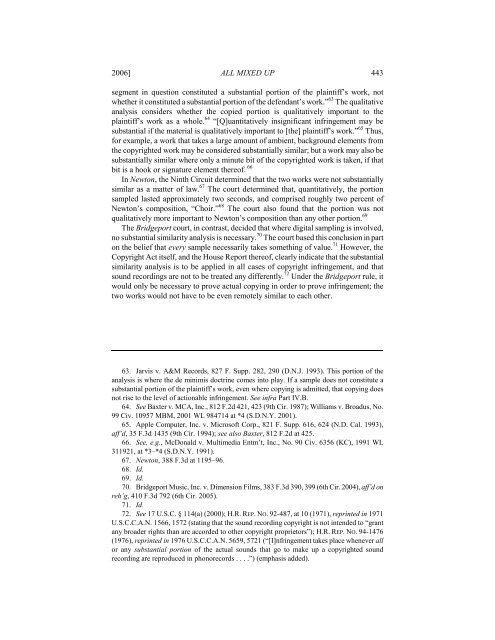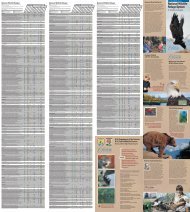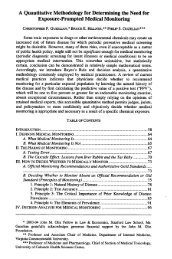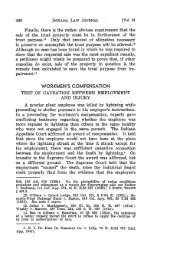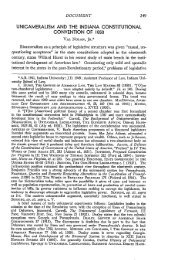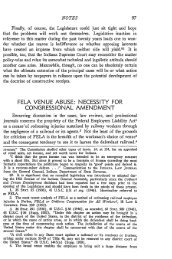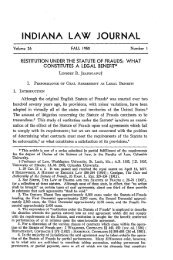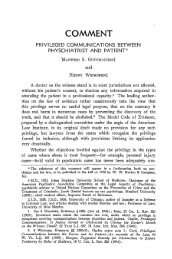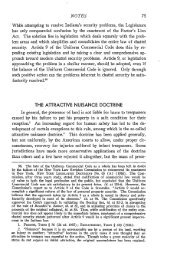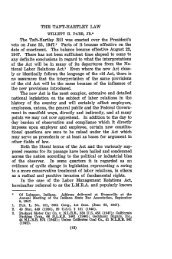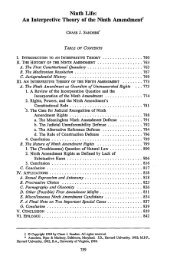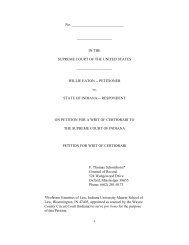Bridgeport Music v. Dimension Films - Indiana University School of ...
Bridgeport Music v. Dimension Films - Indiana University School of ...
Bridgeport Music v. Dimension Films - Indiana University School of ...
You also want an ePaper? Increase the reach of your titles
YUMPU automatically turns print PDFs into web optimized ePapers that Google loves.
2006] ALL MIXED UP 443<br />
segment in question constituted a substantial portion <strong>of</strong> the plaintiff’s work, not<br />
whether it constituted a substantial portion <strong>of</strong> the defendant’s work.” 63 The qualitative<br />
analysis considers whether the copied portion is qualitatively important to the<br />
plaintiff’s work as a whole. 64 “[Q]uantitatively insignificant infringement may be<br />
substantial if the material is qualitatively important to [the] plaintiff’s work.” 65 Thus,<br />
for example, a work that takes a large amount <strong>of</strong> ambient, background elements from<br />
the copyrighted work may be considered substantially similar; but a work may also be<br />
substantially similar where only a minute bit <strong>of</strong> the copyrighted work is taken, if that<br />
bit is a hook or signature element there<strong>of</strong>. 66<br />
In Newton, the Ninth Circuit determined that the two works were not substantially<br />
similar as a matter <strong>of</strong> law. 67 The court determined that, quantitatively, the portion<br />
sampled lasted approximately two seconds, and comprised roughly two percent <strong>of</strong><br />
Newton’s composition, “Choir.” 68 The court also found that the portion was not<br />
qualitatively more important to Newton’s composition than any other portion. 69<br />
The <strong>Bridgeport</strong> court, in contrast, decided that where digital sampling is involved,<br />
no substantial similarity analysis is necessary. 70 The court based this conclusion in part<br />
on the belief that every sample necessarily takes something <strong>of</strong> value. 71 However, the<br />
Copyright Act itself, and the House Report there<strong>of</strong>, clearly indicate that the substantial<br />
similarity analysis is to be applied in all cases <strong>of</strong> copyright infringement, and that<br />
sound recordings are not to be treated any differently. 72 Under the <strong>Bridgeport</strong> rule, it<br />
would only be necessary to prove actual copying in order to prove infringement; the<br />
two works would not have to be even remotely similar to each other.<br />
63. Jarvis v. A&M Records, 827 F. Supp. 282, 290 (D.N.J. 1993). This portion <strong>of</strong> the<br />
analysis is where the de minimis doctrine comes into play. If a sample does not constitute a<br />
substantial portion <strong>of</strong> the plaintiff’s work, even where copying is admitted, that copying does<br />
not rise to the level <strong>of</strong> actionable infringement. See infra Part IV.B.<br />
64. See Baxter v. MCA, Inc., 812 F.2d 421, 423 (9th Cir. 1987); Williams v. Broadus, No.<br />
99 Civ. 10957 MBM, 2001 WL 984714 at *4 (S.D.N.Y. 2001).<br />
65. Apple Computer, Inc. v. Micros<strong>of</strong>t Corp., 821 F. Supp. 616, 624 (N.D. Cal. 1993),<br />
aff’d, 35 F.3d 1435 (9th Cir. 1994); see also Baxter, 812 F.2d at 425.<br />
66. See, e.g., McDonald v. Multimedia Entm’t, Inc., No. 90 Civ. 6356 (KC), 1991 WL<br />
311921, at *3–*4 (S.D.N.Y. 1991).<br />
67. Newton, 388 F.3d at 1195–96.<br />
68. Id.<br />
69. Id.<br />
70. <strong>Bridgeport</strong> <strong>Music</strong>, Inc. v. <strong>Dimension</strong> <strong>Films</strong>, 383 F.3d 390, 399 (6th Cir. 2004), aff’d on<br />
reh’g, 410 F.3d 792 (6th Cir. 2005).<br />
71. Id.<br />
72. See 17 U.S.C. § 114(a) (2000); H.R. REP. NO. 92-487, at 10 (1971), reprinted in 1971<br />
U.S.C.C.A.N. 1566, 1572 (stating that the sound recording copyright is not intended to “grant<br />
any broader rights than are accorded to other copyright proprietors”); H.R. REP. NO. 94-1476<br />
(1976), reprinted in 1976 U.S.C.C.A.N. 5659, 5721 (“[I]nfringement takes place whenever all<br />
or any substantial portion <strong>of</strong> the actual sounds that go to make up a copyrighted sound<br />
recording are reproduced in phonorecords . . . .”) (emphasis added).


